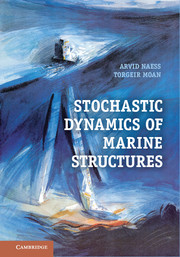Book contents
- Frontmatter
- Contents
- Preface
- 1 Preliminaries
- 2 Dynamics of Single-Degree-of-Freedom Linear Systems
- 3 Dynamics of Multi-Degree-of-Freedom Linear Systems
- 4 Finite Element Method
- 5 Stochastic Processes
- 6 Variance Spectrum
- 7 Environmental Loads
- 8 Random Environmental Processes
- 9 Response Spectrum
- 10 Response Statistics
- 11 Statistics for Nonlinear Problems
- 12 Short-Term and Long-Term Extremes
- 13 Dynamic Load Effects for Design Checks
- 14 Equations of Motion
- 15 Numerical Solution Techniques
- 16 Monte Carlo Methods and Extreme Value Estimation
- A Integrals
- B Poisson Process
- C Statistical Moments and Cumulants
- References
- Index
3 - Dynamics of Multi-Degree-of-Freedom Linear Systems
Published online by Cambridge University Press: 05 February 2013
- Frontmatter
- Contents
- Preface
- 1 Preliminaries
- 2 Dynamics of Single-Degree-of-Freedom Linear Systems
- 3 Dynamics of Multi-Degree-of-Freedom Linear Systems
- 4 Finite Element Method
- 5 Stochastic Processes
- 6 Variance Spectrum
- 7 Environmental Loads
- 8 Random Environmental Processes
- 9 Response Spectrum
- 10 Response Statistics
- 11 Statistics for Nonlinear Problems
- 12 Short-Term and Long-Term Extremes
- 13 Dynamic Load Effects for Design Checks
- 14 Equations of Motion
- 15 Numerical Solution Techniques
- 16 Monte Carlo Methods and Extreme Value Estimation
- A Integrals
- B Poisson Process
- C Statistical Moments and Cumulants
- References
- Index
Summary
Introduction
In Chapter 2, the dynamic equation of motion was established for an SDOF system,and the solutions to different deterministic load conditions were described. Itwas also shown that the SDOF system could be used to model important features ofrigid-body and flexible motions of various structures. The SDOF can betranslational or rotational motion. The number of degrees of freedom is equal tothe number of variables found necessary to describe the dynamic behavior of astructure with the required accuracy. This chapter deals with formulation andsolution of dynamic problems which include both rigid-body motions andstructural deformations, and are based on multiple degrees of freedom.
In Example 2.3.3, the concept of a generalized DOF is introduced, and it isillustrated how this could be used to effectively reduce a large number of DOFsto just one generalized DOF by combining this with the appropriate shapefunction. Thus, the instantaneous position of all mass points in the system werespecified without ambiguity and without redundancy. The simplest example of thisis a mass point moving in a plane, which is described by two coordinates. Ofcourse, the concept of generalized coordinates is not needed in this case.However, a rigid disc moving in a plane needs three generalized coordinates. Arigid body moving in the paper plane, see Fig. 3.1, may be described byuG(t),vG(t), andϕG(t) of the centerof gravity. Clearly, using the three quantities with reference to one of the ends of the body also represents a (unique) set of generalized coordinates. If considered as a rigid body, the articulated loading tower in Example 2.2.8 can be described by a single generalized coordinate (DOF) when a plane motion is considered.
Information
- Type
- Chapter
- Information
- Stochastic Dynamics of Marine Structures , pp. 57 - 97Publisher: Cambridge University PressPrint publication year: 2012
